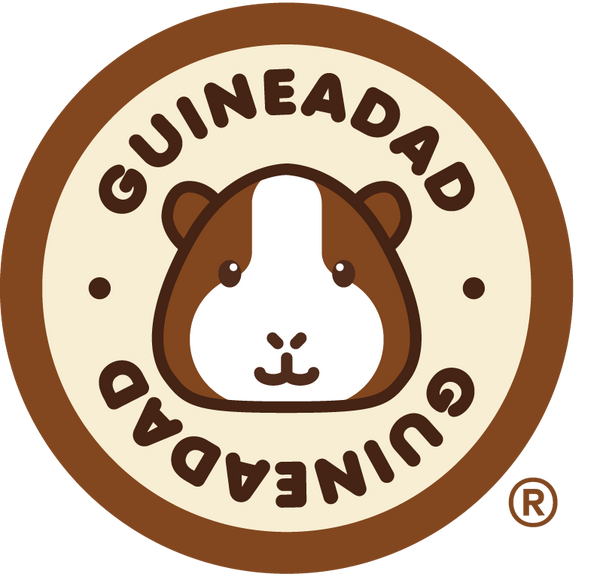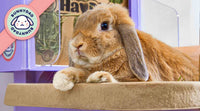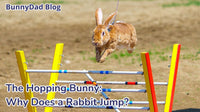Hey there, BunnyGang!
Rabbits come in many different colors and sizes. From the Dutch rabbit, to the Angora, to the hairless rabbit (yes really), there are over three hundred breeds of domesticated rabbits, and 29 known species of wild and domesticated rabbits in total, hopping around the world. In fact, aside from Antarctica, rabbits can be found on every continent in the world.
In this enchanting world of lagomorphs, there’s one breed that can’t help but stand out, due to its gentle nature, fascinating history, and absolutely staggering size — the Flemish Giant Rabbit. Hailing from the picturesque Belgian countryside, these majestic creatures have captured the hearts of rabbit enthusiasts worldwide. Join us on a journey to unravel the mysteries and marvels of the Flemish Giant Rabbit.
While proportionately not very heavy, Flemish Giant rabbits are longer than many average-sized dogs, and still about 3 times the size and weight of typical rabbit breeds. At first glance, Flemish Giants might look a bit imposing, but their charming natures are sure to win you over ver quickly. In fact, these rabbits are often referred to as ‘gentle giants.’
Size & Appearance
The most striking feature of the Flemish Giant Rabbit is undoubtedly its size. These rabbits are true giants, with mature individuals often reaching weights of 13 to 14 pounds, and some exceptional specimens tipping the scales at an astonishing 20 pounds or more. Despite their impressive stature, they possess an elegant and well-proportioned body, characterized by a powerful build and a distinctive arched back.
Average Sizes: Flemish Giants, Pugs (dog), Wild Rabbits, & Guinea Pigs

Darius (The largest Flemish Giant rabbit ever recorded)
51" (129cm)
49lbs (22 kg)
The coats of Flemish Giants come in a range of colors, including steel gray, black, white, blue, and fawn. Their fur is dense, glossy, and velvety to the touch.
Flemish Giant Rabbit Characteristics
Other than being about 3-4 times larger than most domesticated breeds of rabbit, Flemish Giants also have long ears, long broad bodies with sturdy bone structure, thick and glossy fur with a dense undercoat, and females have a dewlap, which is a pouch of fatty tissue underneath their chins. Expectant mothers will often pull out fur from their dewlaps and use the fur to insulate their nests.

How long do Flemish Giant Rabbits live?
A Flemish Giant Rabbit's lifespan averages about 4-6 years, though there have been some Flemish Giants known to live as long as 8 years.
History/Origin
The origins of the Flemish Giant Rabbit (Oryctolagus cuniculus domesticus) date back to the 16th century in Flanders, Belgium. Initially bred for meat and fur, these rabbits quickly gained popularity due to their substantial size and kind temperaments.
Some Flemish Giants started being exported to England in the mid-19th Century, and soon after, they made their way to America. Over the centuries, selective breeding has refined their traits, eventually leading to the Flemish Giants we know and love today.
Diet & Natural Habitat
What do Flemish Giant Rabbits eat?
When someone asks “What do rabbits eat?” they probably aren’t picturing an appetite of this scale. Flemish Giants eat the same food as regular bunnies, including hay, fortified food pellets, and fresh leafy green vegetables – they just eat a whole lot more of it! All bunnies need an unlimited supply of clean water and Timothy hay. Orchard hay is a great alternative for picky eaters, or bunnies parents with allergies.
Keep in mind that an unlimited supply of hay will mean something quite different for a regular-sized bunny and a Flemish Giant. The exact amount will vary depending on each individual rabbit’s needs, but as a rough estimate, for 3x the bunny, expect it to eat 3x the food. Hay should be about 80% of any rabbit’s diet, so make sure you have plenty of access to fresh hay nearby, and budget accordingly.
For pellets, an average rabbit eats about 25g-50g of high-fiber food pellets per day. A Flemish Giant will often consume about 100g-150g of pellets each day.
Where most rabbits will eat 1-2 handfuls of leafy greens per day, a Flemish rabbit will enjoy 3-5 handfuls.
Whatever your rabbit’s eating habits are, they should be closely monitored and adjusted as necessary for your bunny to maintain a healthy weight.
Unlike many other breeds of rabbit, Flemish Giants don’t reach maturity until they’re about 18 months old. Due to this, many vets recommend monitoring and adjusting their food needs even more closely, as their appetites and needs are likely to fluctuate more before they reach maturity.
Varying your rabbit's diet with plenty of green vegetables and herbs is important for your rabbit’s nutrition, and will help stop them from getting bored. Many rabbits also like to search for their food, so placing it in different places for them to find can help stimulate their appetites as well.
Make sure to research any vegetables before feeding them to your rabbit, and introduce new foods slowly in small portions.
Personality/Temperament

Similar to many larger dog breeds, Flemish Giant Rabbits are bred specifically to be sweet and docile. At their size, they’d be dangerous otherwise! There is, of course, variation among all individual animals, but the majority of Flemish Giants have sweet, affable dispositions, and many don’t even mind being cuddled or held, as long as they feel fully supported.
These gentle giants form strong bonds with their human companions and love calmly lounging side-by-side.
Grooming, Care, and Maintenance
Providing optimal care for a Flemish Giant Rabbit requires attention to their unique needs. As well as giving them a complete and healthy diet, and ensuring they have ample space to move around, exercise, and stretch their long legs, a frequent and consistent grooming routine is crucial for their physical health and mental stimulation.
In addition to needing a lot more food than smaller rabbits, Flemish Giants also need more grooming and attention than most smaller rabbits.
Regular grooming sessions are recommended to maintain their luxurious coats and prevent matting. Additionally, regular veterinary check-ups should be scheduled to monitor their health and address any potential concerns.
Just like with all rabbits, it’s important to groom your rabbit gently, using the correct tools. In addition to their daily fur, skin, eye, and ear inspections, brushing your rabbit every day with a Cuddlecomb or soft brush can be very soothing and enjoyable to them. It’s a good way to bond with your rabbit and will make them more comfortable being handled by you. It’s also a good way to dislodge any loose clumps of fur or debris.
For a more in-depth guide, and a list of necessary tools, check out parts 1 & 2 of our blogs on grooming your rabbit.
“Grooming Your Pet Rabbit (Part 1)”
https://guineadad.com/blogs/news/grooming-your-pet-rabbit-part-1
“Grooming Your Pet Rabbit (Part 2)”
https://guineadad.com/blogs/news/grooming-your-pet-rabbit-part-2
Socializing with Other Rabbits
All rabbits, including Flemish Giants, need at least one rabbit friend. Rabbits are social animals and loneliness can have seriously detrimental impacts on their health.
Bunnies of different sizes and breeds can be happily bonded, but too drastic a size difference may not work, as your rabbits won’t view each other as members of the same herd. This can also be dangerous (typically for the smaller rabbit). 
Socializing with People
Flemish Giant Rabbits are known for being especially social and sweet natured, often forming very strong bonds with their humans. To help keep your rabbit accustomed to being handled by you, make sure you interact with them at least a couple of times a day. As rabbits are typically much more comfortable with their feet on the ground, going down to meet them on their level will often make them more comfortable than picking them up to meet you on yours.
For some perspective when it comes to respecting your rabbit’s personal space, try imagining an enormous primate, more than 5 times your size, periodically scooping you off the ground and going nose to nose with you. Even animals with the best of intentions (you) can be terrifying if they don’t respect your personal space and boundaries.
A Grand Companion for Those Who Are Sufficiently Equipped
The Flemish Giant Rabbit makes a wonderful companion to those with enough time, space, and food to accommodate them. Their imposing size, gentle disposition, and rich history make them a captivating choice for both seasoned rabbit enthusiasts and newcomers to the world of lagomorphs.
We hope we’ve given you some good insights into this fascinating and lovable breed of rabbit. For more fun rabbit facts, tips, and tricks, check out some of our other blogs!
See you soon, BunnyGang!
~ BunnyDad
- “Bunny Sounds and their Meanings”
https://guineadad.com/blogs/news/bunny-sounds-interpreting-12-of-the-most-common-rabbit-noises
- “10 Signs Your Rabbit Loves You”
https://guineadad.com/blogs/news/10-signs-your-rabbit-loves-you
- “Famous Rabbits in Pop Culture”
https://guineadad.com/blogs/news/famous-rabbits-from-pop-culture
“How to Groom Your Rabbit (Part 1)”
https://guineadad.com/blogs/news/grooming-your-pet-rabbit-part-1









1 comment
slayyyyyyyyyyyyyyyyyyyyyyyyyyyyyyy!!!!!!!!!!